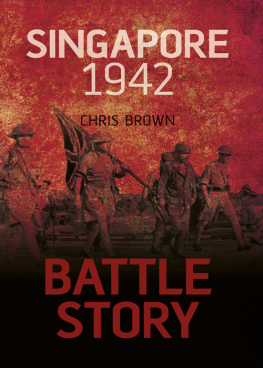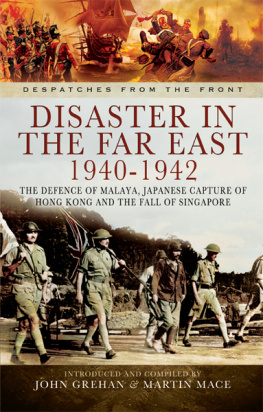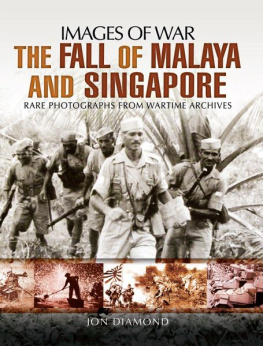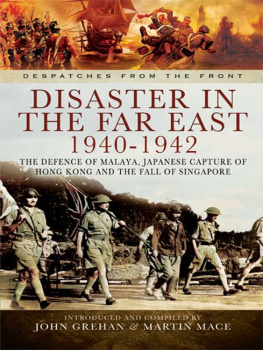 | Australian Army Campaigns Series 5 |
MALAYA 1942
BRIAN FARRELL & GARTH PRATTEN


2011
Copyright Army History Unit
Campbell Park Offices (CP2-5-166)
Canberra ACT 2600
AUSTRALIA
(02) 6266 4248
(02) 6266 4044 fax
Copyright 2009 Commonwealth of Australia
First published 2009
Reprinted 2011
This book is copyright. Apart from any fair dealing for the purposes of private study, research, criticism or review as permitted under the Copyright Act, no part may be reproduced, stored in a retrieval system or transmitted in any form or by any means, electronic, mechanical, photocopying, recording or otherwise, without written permission.
Authors: Farrell, Brian P. 1960- & Pratten, Garth, 1973
Title: Malaya 1942
ISBN: 978-0-9805674-4-1 (pbk.)
Series: Australian army campaigns series; 5
Notes: Includes index. Bibliography
Subjects: World War, 1939-1945CampaignsMalaya.
World War, 1939-1945CampaignsSingapore.
World War, 1939-1945Participation, Australian.
AustraliaHistory, Military.
Dewey Number: 940.542951
Layout and design by Margaret McNally, Canberra, ACT
Printed by: Big Sky Publishing Pty Ltd, Sydney
Front Cover: AWM 068592
Back Cover: AWM 009249/07; AWM 011301; AWM 007180
Title Page: AWM 009827
CONTENTS
ACKNOWLEDGEMENTS
For the men of the 8th Australian Division soldiers, not prisoners.
With one author in the United Kingdom and another in Singapore, and the rest of the project team in Australia, pulling together Malaya 1942 has been a significant logistical effort. Our first thanks must go to Glenn Walhert who has driven the project with a deft hand from beginning knowing when to spare us the rod, and also knowing when he needed to give us a whack with it. Glenn has also contributed some of the material for the feature items throughout the book.
Several others have made their own contributions to Malaya 1942 and are deserving of recognition and our gratitude: Peter Dennis for suggesting the volume; Mark Walhert for the maps, organisation charts, and digital images; Jeff Isaacs for his original artwork; Defence Publishing Service for the cover design; John Donovan for his diligence with the editing; and Margaret McNally for the book design and typesetting. We would also like to thank John Coates for his kind permission to reproduce maps from An Atlas of Australias Wars.
The ongoing support of Roger Lee and the Army History Unit for this project in particular, and the conduct of quality research and writing in the field of Australian military history in general, should also be acknowledged. We are grateful for the opportunity to contribute to the Australian Army Campaign Series.
Garth would also like to acknowledge the assistance of Mark Johnston, Karl James and Garth OConnell in answering research queries that could not be nailed down in the United Kingdom; and the support, and forbearance, of his colleagues at the Royal Military Academy Sandhurst and in the wider British Army, particularly Dr Jennifer Medcalf, Major Rachael de Renzy Channer, and the Mortar Platoon of the 3rd Battalion, the Princess of Waless Royal Regiment.
Brian Farrell and Garth Pratten
MALAYA 1942
INTRODUCTION: FIGHTING SOLDIERS
The campaigns for Gallipoli and Singapore were fought in two separate world wars, 27 years apart, in very different environments. In Australian cultural memory, however, both events have been shaped to fit a familiar nationalist mantra, a story of innocent but brave young Australians sacrificed by an uncaring and incompetent British politico-military establishment. In 1992, then Prime Minister Paul Keating reinforced this mantra, when he accused Britain of having betrayed Australia by sacrificing the defence of the Asia-Pacific region, and in particular Singapore, to concentrate on fighting the war in Europe and the Middle East.
The specific details of this particular tale, which could be described as the Singapore myth, would be well known to many readers. They include a chronic lack of air support, guns facing the wrong way, and a British refusal to give Australia back the troops sent to the Middle East earlier in the war. So too is its ending, capitulation to a brutal enemy condemning thousands to the horrors of Japanese prisoner of war camps. Ultimately, Australia remembers the men of the 8th Division as the emaciated victims of that experience.
The fall of Singapore, however, was the end of a longer story. Before the Japanese landed on Singapore Island on the night of 8 February 1942, the 8th Division had participated in the last part of a hard fought campaign on the Malayan peninsula to try to keep them at bay. The divisions part in this campaign lasted under three weeks, from 14 to 30 January, but included fighting as bitter, and as costly, as any experienced by Australian troops against the Japanese. Ultimately, the sheer scale of the disaster at Singapore overwhelmed the story of the Malayan campaign.
This is the first of two volumes in the Australian Army Campaign Series that will examine the fighting in Malaya and Singapore. In his classic essay The Uses and Abuses of Military History, the renowned British military historian Sir Michael Howard argued that military history needed to be studied in width, depth and context. This volume, and its companion, follow Howards lead. It ranges from tactics to grand strategy to put the 8th Divisions experience in Malaya in its full context.
To quote Howard further, this volume aims to make tidy outlines dissolve and recreate the omnipresence of chaos, revealing the part played not only by skill and planning and courage, but by sheer good luck, and also the effect of the lack of these factors. Malaya and Singapore have been separated to provide sufficient scope to do this. Although the operations on the mainland and on the island were intimately related, they were quite different in character, and thus deserve separate treatment.
The campaign on the mainland was one of manoeuvre fought, on the British and Commonwealth side, by an intact, although not necessarily cohesive, army. The fight for Singapore, however, was akin to a confused brawl, fought by a broken army struggling to cope with all manner of problems outside the actual fighting, such as stragglers, the civilian population, and the evacuation of non-combatants.
This volume does not beat a nationalist drum. It clearly recognises Australias role as part of an infant coalition fighting a global war. By reducing history to a set of shallow clichs, we rob ourselves on two accounts. First, we deny ourselves an insight into the true complexity of the human experience of war. Second, we deny ourselves the chance to profit from that experience.

Australian troops in fighting order on the move during the Malayan campaign. (AWM 011303/32)
Australias Malayan campaign is a story of bravery and fear, of selflessness and blatant self-serving, and of incompetence and steadily growing proficiency. The 8th Division found itself operating within a fractured and poorly prepared force, seeking to make the best of an ill-founded strategy. Australians, however, from the Commonwealth government down, were just as complicit in the eventual defeat in Malaya as any of their alliance partners.
Next page
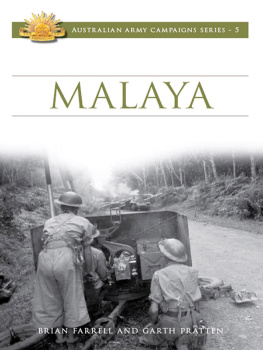


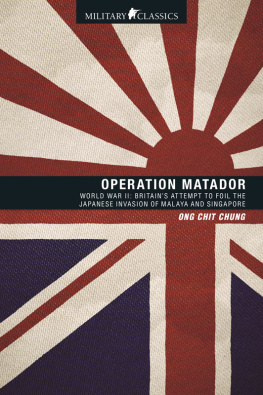



![Haselden Mark - Buffaloes over Singapore: [RAF, RAAF, RNZAF and Dutch Brewster fighters in action over Malaya and the East Indies 1941-42]](/uploads/posts/book/212345/thumbs/haselden-mark-buffaloes-over-singapore-raf.jpg)
